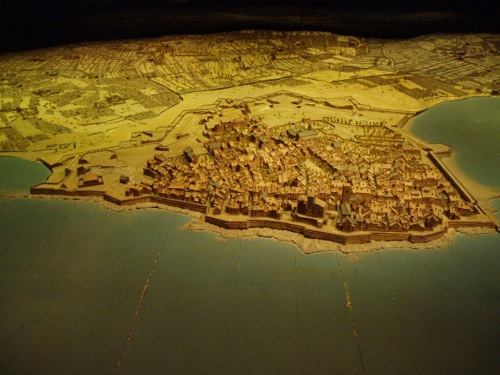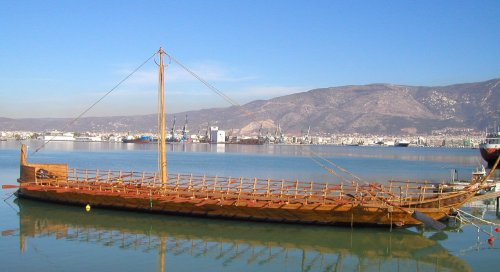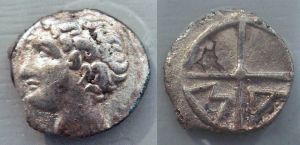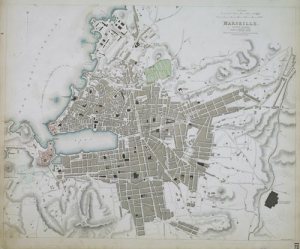Continuing from the first part:http://akrokorinthos.blogspot.gr/2013/12/massalia-when-marseilles-was-greek.html


Antibes during the Renaissance, the ancient Greek Antipolis, the third largest Massaliot colony. The ancient Greek city covered about the same area.
-
CONTINUED FROM PART I
The Gauls (Celts) gradually extended their territory in modern South France at the expense of the Ligurians, the Iberians and the Wasconians (ancestors of the Basques), either by conquest or by the direct adoption of the La Tene culture by the aforementioned natives and thence their upcoming Celtisization. At first, the Massaliots did not clash with the newcomers. As we have seen, the two peoples were familiar to each other due to their trade and the beneficial effect of Massalia. Now they had territorial contact also. Besides their common commercial interests, they had common geopolitical as well, since they both ruled Ligurian subjects. In the early 4th century, the entire Gaul had become a Massaliot zone of commercial and cultural influence. For this reason, the Massalialiots had very little or no regard for the control of the Iberian Peninsula and the Columns of Hercules (modern Gibraltar) which they had left to the Carthaginians. After all, the Carthaginian power prevented them from this aim. The only interesting for both peoples beyond the Pillars of Hercules, was the tin of the Cassiteridae islands (probably the Isles of Scilly in Cornwall), which however the Massaliots acquired without problems via the commercial roads of Gaul. In contrast, the Carthaginians had to undertake the long and dangerous sea voyage from the Mediterranean to Britain via the Atlantic, because the roads of Gaul remained forever closed to them due to the Massaliot influence in the land. Because of this situation, there was an unofficial agreement between Massalia and Carthage, whereby Gaul was a Massaliot zone and the Iberian Peninsula was a Punic zone. Later the agreement became official, when the two sides fixed the boundary between the two zones in the River Iber (modern Ebro in Aragon, Spain).
A Greek penteconter, the warship used by the Phocaeans who founded Massalia and many more colonies in the Western Mediterranean. The Massaliots used extensively the penteconter till the adoption of the Corinthian trireme. Afterwards, the penteconter was used mostly as a coastguard vessel.
-
Only some decades after her foundation, Massalia has sent her navigators to explore the Atlantic coast. In the 6th century BC, Euthemenes the Massaliot and his seafarers crossed the Strait of Gibraltar and sailed along the coast of Africa ending his journey in the estuary of the Senegal River, according to the most probable modern estimate. But Pytheas the Massaliot is more famous – an unfair situation for the forgotten Euthemenes. Pytheas followed the opposite direction in the Atlantic, sailing towards the frozen seas of the North (ca. 335-330 BC). Some modern historians have theorized that Pytheas’ mission was funded by Alexander the Great, who at the same time was crushing the Persians in Asia. It is well known that the great conqueror intended in the future to lead his armies to the West, so he needed first-hand information about the peoples and the countries of Western Europe. Modern European researchers believe that Pytheas used for his renowned voyage a Gallic vessel, e.g. a ship of the Armorican Veneti seafarers. However, he had no need for them despite their high sailing quality, because his ship was most probably an ‘olkas’ (ολκάς), a Greek merchant vessel which because of its hemispherical shape could withstand without problems the high waves of the Atlantic (as opposed to the trireme or the penteconter whose sailing in the Ocean was very risky, being vessels made for the waves of the Mediterranean).
The ancient quotation which states that the Carthaginians were guarding the Strait of Gibraltar and did not let anyone to sail in the Atlantic without their permission, has no historical value. The Phoenicians could not prevent the Massaliots or any other Greeks or even the Etruscans to sail in the ocean, when they wanted it. The Massaliots had won several victories against the Punic war fleet, as it is indicated by the trophies of naval victories that they sent as tributes to the Panhellenic Sanctuary of Delphi (Thucydides, Justin, Strabo and Pausanias). Moreover Pytheas mentions in his writings, the Iberian rivers which flow into the Atlantic, a reference which means that he circumnavigated the Iberian Peninsula. The view that if the Massaliots really wanted to sail in the Atlantic, they would be prevented by the Carthaginians, is rather improbable. Instead, a modern British historian specialized in the history of Massalia, provides indications for the possibility that the Massaliots and the Carthaginians have cooperated in the exploration of the Atlantic.

A French romantic depiction of the founding legend of Massalia (1875): the princess Gyptis passes indifferent by the frustrated indigenous suitors and selects the Greek Protes.
-
Pytheas and his men sailed by the Atlantic coasts of Europe and crossed the Strait of the Irish Sea which separates Ireland from Great Britain. They arrived in Iceland or according to other theories, in the islands of Shetland or in Norway. In the same or in another mission, they sailed by the coast of the North Sea and most important, they discovered the Baltic Sea which was unknown until then in the Mediterranean world. Pytheas watched carefully the tribes that he met and he recorded a lot of information about their culture and everyday life, in his work. Most of these tribes were Celtic and Germanic. Although his work has not survived, fragments of it survived in the works of other ancient writers, being an important source on the Celtic and Germanic World of the 4th cent BC.
The Massaliot influence on the Galatians is more evident in the Greco-Gallic city of Glanum in Provence. Ptolemy mentions Glanum as a city of the Salyes Gauls but it is clear that during the Hellenistic period, a part of her population were Massaliot Greeks. The city acquired then many Greek elements, which are more obvious in her architecture. Her residents had a Greek state name, calling themselves ‘Glanikoi’ (Γλανικοί). But the original Gallic elements were not lost. Apart from the Gallic inscriptions, during the excavations a place in the city was found, where cut-off heads of defeated enemies were nailed in piles, a typical Celtic habit. The Greek influence was not limited in Glanum. During the Hellenistic period, the capital of the Salyes in the modern site Entremont, was rebuilt on a Greek urban plan. In the place of the old Gallic fortress, a great city was founded following the urban plan and the architecture of the neighboring prototype: Massalia. In Entremont as well, the Greek elements coexisted with the cut-off skulls of the enemies nailed in the walls of the city.
-
The alliance of Massalia with Rome dated back to 600 BC. In 132 BC, Massalia saved her mother city Phocaea from the destruction by the Roman army, when she interceded in the Roman Senate. Massalia helped Rome in the great ‘Double’ Punic War (264-201 BC) with her army, navy and diplomacy. Moreover Carthage was the greatest enemy of both cities. After the final defeat of Hannibal, the Romans extended their military presence in the country surrounding Massalia in order to ensure a safe land route from Italy to their Spanish provinces. The Salyes (also known as Saluvii) were furious because of the Roman advance and thereby they attacked Massalia (154 BC). The Massaliots and the Romans repulsed them, but in 125 BC the Salyes returned reinforced with the Allobriges, a neighboring Galatian people. Rome sent to Massalia a consular army which defeated the Gauls. This victory although saved Massalia from the Gauls, basically turned the city into one of the subject allies (socii) of Rome (122 BC). In return, the Romans extended the territory of Massalia turning over to her Gallic lands.
A little later, the Roman armies subjugated permanently the Salyes and the Allobriges while the Roman conquest proceeded west to the Pyrenees, subduing the Volcae Gauls (118 BC). The Romans unified the conquered territories into a new province, which extended to the North as far as the modern Lake Geneva. They ceded approximately one third of the conquered areas to Massalia. Thereby the city prospered more because of the income from these extensive lands. The remaining territory became the Roman province of Galatia Narbonensis, which the Romans often called simply as the ‘Province’ (Provincia) as opposed to the rest of Gaul which was free yet. The current French name ‘Provence’ originates from the Roman name for the region.
During the Roman civil wars, Massalia supported Marius against Sulla and in the quarrel between Pompey and Caesar, she supported Pompey. The army of Caesar besieged and occupied it despite the brave effort of the Massaliot navy against the Roman warships (49 BC). Caesar did not destroy the city but took away all her treasures of art and annexed to the Roman province all of her colonies except Nicaea and a great part of her territory. Massalia was virtually annexed to the Roman State. Despite her savage looting by the Caesarian army and the commercial competition of the neighboring Roman colony Narbon, Massalia remained a rich commercial city with famous Greek schools of medicine, philosophy and other sciences with many Roman and Gallo-Roman students. Her Ionic dialect was lost in favor of Latin until the third century AD. Today, in the entrance of the port of Marseille, in a heavy metal plate mounted by the Municipality of Marseille, is written that in 600 BC Greek colonists landed at this site and founded the city
an article from:http://periklisdeligiannis.wordpress.com



No comments:
Post a Comment